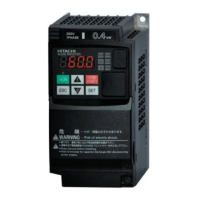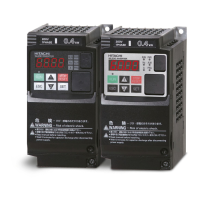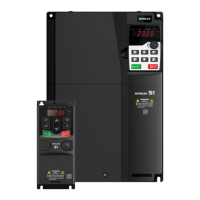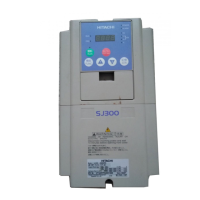Chapter 15 Tips/FAQ/Troubleshooting
15-2-4
Possible causes and countermeasures
Power supply
overvoltage
error
When the overvoltage
condition of the power supply
voltage continues for 100
seconds while the inverter is
stopped, the inverter trips. The
overvoltage detection value of
the P-N voltage is approx. 390
VDC (200 V class) or 780 VDC
(400 V class).
Is the power supply voltage too high?
→ Decrease the power supply
voltage.
→ Suppress power supply
fluctuations.
→ Insert an AC reactor into the
input.
Temperature
detection error
When the cooling fin
temperature detection system
is judged to be abnormal such
as broken wire, the inverter
trips.
Inverter failure.
→ Repair.
Cooling fin
temperature
error
When the main circuit part
temperature exceeds the
specified value for reasons
such as high ambient
temperature, the inverter trips.
Is the inverter mounted vertically?
→ Check the installation.
Is the ambient temperature too high?
→ Lower the temperature.
Is the cooling fan not stopped?
→ Set "Cooling fan control method
selection [b092]" to "Always (00)".
→ Check the power supply of the
cooling fan.
Is the cooling fin clogged?
→ Clean the fin.
4-1-1
9-10-6
9-11-6
16-2-2
When a malfunction or
abnormality occurs in the
communication of the built-in
CPU, the inverter trips.
Is there a large noise source nearby?
→ Noise suppression.
Inverter failure.
→ Repair.
When a problem occurs in the
main circuit board, the inverter
trips.
Is there a large noise source nearby?
→ Noise suppression.
Inverter failure.
→ Repair.
Analog current
input error
When an excessive current
flows through the analog
current input terminal [Ai2],
the inverter trips.
Is [Ai2] wiring short-circuited or
incorrect wiring?
→ Check the wiring.
Control circuit board failure.
→ Repair.
When an instantaneous
overcurrent occurs, the
inverter trips to protect the
main element.
(This trip does not allow retry
operation. The power must be
turned on again.)
Is there an output short circuit?
→ Check the output line.
Is there a ground fault?
→ Check the output wires and
motor.
Is there any damage to the main
element?
→ Checking IGBT.
(See "16.2.4 Checking the
Inverter and Converter Section".)
Thermistor
error
*3
(Motor
temperature
error)
When the thermistor input
[PTC] function is enabled and
an abnormal temperature is
detected by the resistance
value of the external
thermistor, the inverter trips.
Is the motor temperature too high?
→ Check the temperature.
Is there any damage to the
thermistor?
→ Check the thermistor.
Is there noise contamination to the
thermistor signal?
→ Wiring separation.
*2. When these errors occur, the reset operation is not accepted. Turn off the power once. If the same error occurs
the next time the power is turned on, there is a possibility of failure. Please contact your supplier or local Hitachi
sales office.
*3. If thermistor is not connected, disconnection or failure while the [PTC] is assigned to the input terminal, E35 will
occur again even after resetting. In this case, connect a thermistor or short-circuit between [5]-[L] terminals before
turning on the power.

